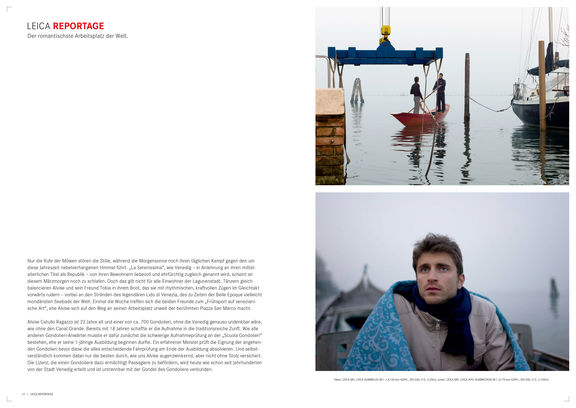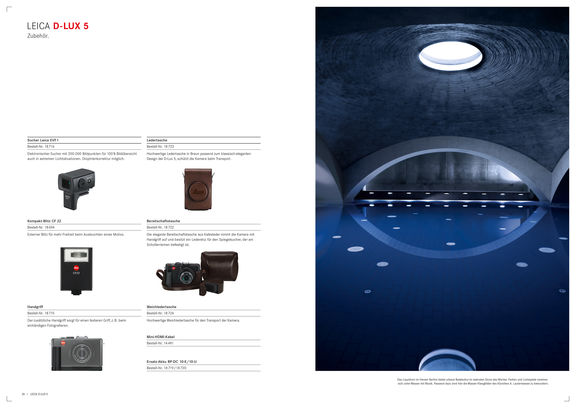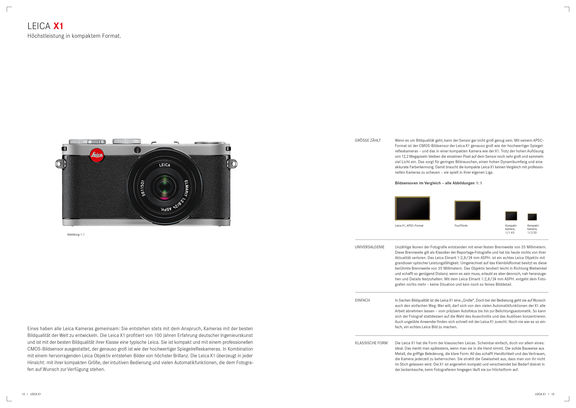Captions

In the case of captions for emotive images, there is a fundamental differentiation between purely informative and purely emotive captions.
Informative captions
Captions of a purely informative nature transform an image into a proof of performance: they state the camera, the lens, the ISO sensitivity, the aperture value, and the shutter speed. Here, the product names are set in caps. They always begin with a capital letter, but are set without any punctuation mark at the end.
Example:
LEICA NOCTILUX-M 50 f/0.95 ASPH., ISO 160, f/0.95, 1/250 s
Exception: A period is set if the image caption ends with the term ASPH.
If a page displays several images, the details can be combined in a single caption. The
caption begins with a capital letter. The individual details are separated by a semicolon.
There is no punctuation mark at the end of the caption.
Example:
Top: LEICA APO-SUMMICRON-M 75 f/2 ASPH., ISO 320, f/10, 1/125 s;
bottom: LEICA SUMMILUX-M 35 f/1.4 ASPH., ISO 320, f/1.4, 1/15 s
Be aware of spelling differences of lenses in German and English. Read more...

Emotive Captions
Captions for emotive images can tell the story of the image shown and can omit technical details and exposure parameters. Here, mixed case is employed and the caption ends with a punctuation mark.
Example:
The sun shines again on the way back to the hotel. The heavy storm is forgotten.

Captions for Product Illustrations
Illustrations of products and product characteristics may also be accompanied by captions. These, however, are purely informative. The text is set in mixed case. These captions may contain several unrelated blocks of information. These are separated by commas. The captions end with a punctuation mark . Exceptions: The caption “Full-size view” and single-word captions are written without a punctuation mark.
Example:
Available in silver chrome and black paint finish.
Exceptions without a punctuation mark:
Full-size view
Captioning of Press Images
Captions of product images describe the camera and/or lens, equipment or accessories shown on the photo and the type of view. These details are spearated with an underscore. Furthermore, the colour mode (RGB or CMYK) is stated.
Example:
Leica M Monochrom_Typ246_Leitz_Apo-Summicron-M_50_ASPH_top_CMYK
Leica M Monochrom_Typ246_Leitz_Apo-Summicron-M_50_ASPH_right_RGB
Leica Elpro 52_front_CMYK
Leica SF60_back_CMYK
Press imags of exhibitions always need to incorporate copyright information. If available, the caption of the respective photograph is used. Alternatively, the title of the series or exhibition. If a series of images should be named identically, they can be appropriately numbered. If a photographer has a preference for naming press photos, this has to be taken into account.
Example:
1_Hiding from Baba Yaga © Nanna Heitmann
2_Hiding from Baba Yaga © Nanna Heitmann
Geraldine Chaplin, 2012 © Anatol Kotte
Christer Strömholm Nana, Place Blanche, Paris 1961 © Christer Strömholm Estate 2014
If people are depicted in images, they must be identified by name from left to right (L to R:) in the caption. If only two persons are shown, identify them as follows (e.g. Max Mustermann (left) with Erika Mustermann). Depending on the number of persons depicted and the space available for the caption, the first names of the persons may be abbreviated to initials. The names in captions must be separated by commas.
Example:
Left to right: Max Mustermann, Erika Mustermann
Left to right: M. Mustermann, E. Mustermann
Image Captions in Exhibitions
This may vary: When receiving the image captions by the artist, we do not adjust these according to the Brand Guide. However, we can give artists the following recommendation:
Example of an Exhibition at Leica Galerie Wetzlar:
Title of Image, Place Year
Further example with Title and Sub-Title:
Title: NAME OF ARTIST
TITLE OF EXHIBITION
Sub-Title: City, Country Year
Example of a bilingual image caption:
Title of the Image in National Language
Title of Image in English
Place Year
For specific PR guidelines, please contact the Global Corporate Communications Team.